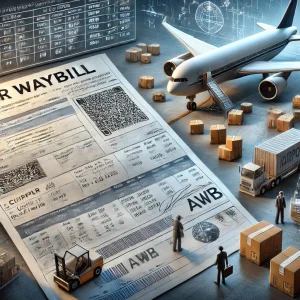Air Waybill (AWB): The Ultimate Guide for Shippers in 2024

What is an Air Waybill (AWB)?
An Air Waybill (AWB) is a critical document in air freight shipping that serves multiple purposes:
- Receipt of Goods: It acts as a confirmation that the airline has received the shipment.
- Contract of Carriage: It represents a legal agreement between the shipper and the airline.
- Tracking Document: It allows all parties to track the shipment throughout its journey.
- Customs Declaration: It provides necessary information for customs clearance.
Key Characteristics of an AWB:
- Non-negotiable instrument
- Standardized format designed by IATA
- Unique 11-digit number for identification
- Available in both paper and electronic (e-AWB) formats
The Importance of Air Waybills in International Shipping
Air Waybills play a crucial role in the logistics and supply chain management of international air freight. Here’s why they’re so important:
- Legal Protection: They provide a legally binding agreement between parties.
- Efficiency: They streamline the shipping process by consolidating essential information.
- Transparency: They offer real-time tracking capabilities for all stakeholders.
- Customs Compliance: They facilitate smooth customs clearance procedures.
Components of an Air Waybill
A typical Air Waybill contains the following key information:
- Shipper’s name and address
- Consignee’s name and address
- Issuing carrier’s name and address
- Airport of departure (three-letter code)
- Airport of destination (three-letter code)
- Declared value for customs
- Number of pieces and total weight
- Description of goods
- Special handling instructions
- Charges summary
- Signature of shipper or agent
Types of Air Waybills
There are two main types of Air Waybills:
- Airline-Specific AWB: Pre-printed with the airline’s name, logo, and AWB number.
- Neutral AWB: Generic format that can be used with any airline.
Additionally, the industry is moving towards:
- Electronic AWB (e-AWB): Digital version that reduces paper usage and increases efficiency.
How to Obtain an Air Waybill
Obtaining an Air Waybill is a straightforward process:
- Through Airlines: Most airlines provide AWBs directly to shippers or freight forwarders.
- Via Freight Forwarders: These intermediaries often handle AWB preparation as part of their services.
- Online Platforms: Many carriers offer online tools to create and manage e-AWBs.
- IATA Website: For e-AWB agreements and standards.
The Air Waybill Process: Step-by-Step

- Preparation: Shipper or freight forwarder prepares the AWB with accurate information.
- Submission: The completed AWB is submitted to the airline.
- Verification: Airline checks the AWB for accuracy and compliance.
- Acceptance: Once verified, the airline accepts the shipment and AWB.
- Distribution: Copies of the AWB are distributed to relevant parties.
- Tracking: The AWB number is used to track the shipment throughout its journey.
- Delivery: The AWB is used for customs clearance and final delivery to the consignee.
Air Waybill vs. Bill of Lading: Key Differences
While both documents serve similar purposes, there are crucial differences:
Aspect | Air Waybill | Bill of Lading |
Negotiability | Non-negotiable | Negotiable |
Mode of Transport | Air freight | Ocean freight |
Document of Title | No | Yes |
Delivery Without Original | Possible | Not possible |

Common Mistakes to Avoid with Air Waybills
- Incorrect or incomplete information
- Mismatched description of goods
- Inaccurate weight or dimensions
- Overlooking special handling instructions
- Failing to sign the AWB
The Future of Air Waybills: e-AWB and Beyond
The air freight industry is rapidly moving towards digitalization:
- e-AWB Initiative: IATA’s push for paperless air cargo processes
- Blockchain Integration: Enhancing security and traceability
- IoT and Smart Contracts: Automating AWB processes and updates
Legal Considerations and Liability
Understanding the legal aspects of AWBs is crucial:
- AWBs are subject to international conventions like the Montreal Convention
- They limit carrier liability in case of loss or damage
- Shippers can declare higher value for increased liability coverage
Best Practices
- Double-check all information for accuracy
- Use clear, precise language in descriptions
- Keep copies of all AWBs for your records
- Understand liability limits and consider insurance
- Stay updated on e-AWB developments and regulations
- Train staff regularly on AWB procedures and best practices

Conclusion: Mastering Air Waybills for Efficient Shipping
Air Waybills are more than just shipping documents; they’re the backbone of international air freight operations. By understanding their importance, components, and proper usage, shippers can ensure smoother, more efficient, and legally compliant shipments.
As the industry continues to evolve with digital innovations like e-AWBs, staying informed and adaptable will be key to maintaining a competitive edge in the global marketplace. Whether you’re a seasoned shipper or new to international logistics, mastering the ins and outs of Air Waybills is an essential skill in today’s interconnected world of commerce.
Remember, while AWBs may seem complex at first, they’re designed to simplify and standardize the shipping process. With the knowledge gained from this guide, you’re well-equipped to navigate the world of air freight shipping with confidence and expertise.
